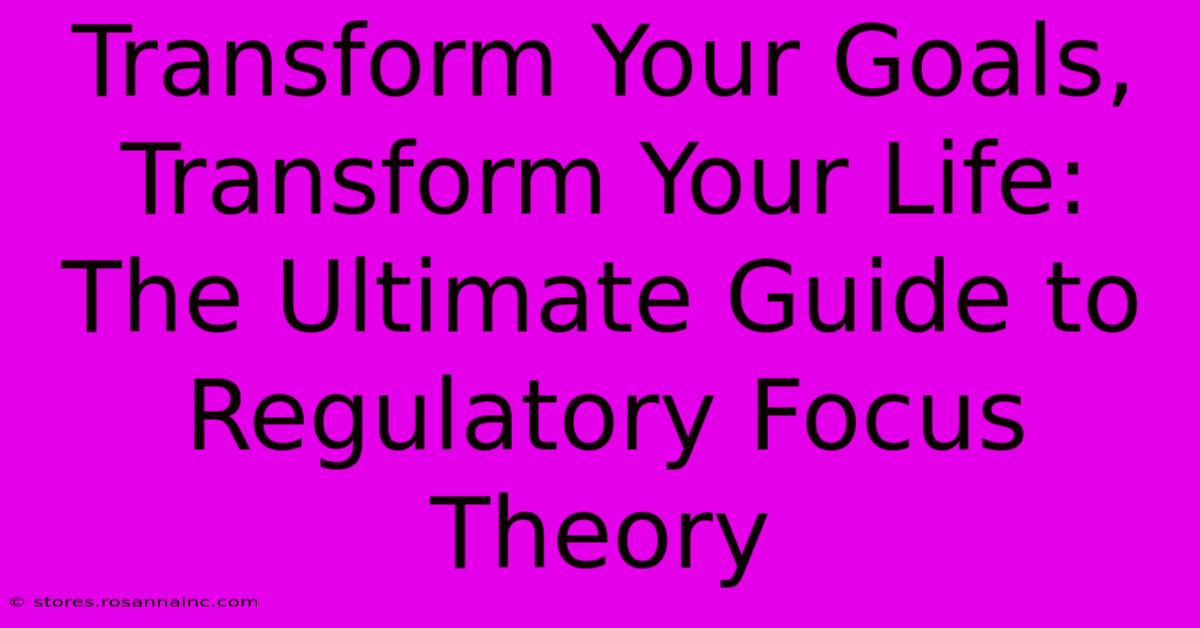Transform Your Goals, Transform Your Life: The Ultimate Guide To Regulatory Focus Theory

Table of Contents
Transform Your Goals, Transform Your Life: The Ultimate Guide to Regulatory Focus Theory
Are you tired of setting goals that never quite seem to materialize? Do you find yourself constantly battling procrastination and feeling overwhelmed? Understanding Regulatory Focus Theory can be the key to unlocking your true potential and transforming your life. This comprehensive guide will explore the power of this theory and provide actionable strategies to help you achieve your aspirations.
What is Regulatory Focus Theory?
Regulatory Focus Theory (RFT), developed by psychologists E. Tory Higgins and colleagues, suggests that individuals approach goal pursuit in two distinct ways: promotion focus and prevention focus. These are not mutually exclusive; instead, they represent different motivational orientations that influence how we think, feel, and behave.
Promotion Focus: Striving for Gains
A promotion focus emphasizes advancement and accomplishment. Individuals with a promotion focus are driven by hopes, aspirations, and the desire for positive outcomes. They focus on ideals, approaching tasks with a "growth mindset" and seeking opportunities for advancement. Think of it as striving for gains: achieving success, experiencing pleasure, and realizing your potential. Key characteristics include:
- Ideal self: Focusing on what they want to be.
- Approach motivation: Moving towards desired outcomes.
- Positive emotions: Experiencing joy, excitement, and pride upon achieving goals.
- Optimism: Maintaining a positive outlook and believing in their ability to succeed.
Prevention Focus: Avoiding Losses
In contrast, a prevention focus emphasizes security, safety, and the avoidance of negative outcomes. Individuals with a prevention focus are driven by a sense of responsibility and the desire to fulfill obligations. They focus on "ought" selves, meticulously planning and prioritizing tasks to ensure they avoid failure. Think of it as striving to avoid losses: preventing mistakes, avoiding negative consequences, and maintaining stability. Key characteristics include:
- Ought self: Focusing on what they should be.
- Avoidance motivation: Moving away from undesirable outcomes.
- Negative emotions: Experiencing anxiety, guilt, and fear of failure.
- Caution: Being careful and deliberate in their actions.
Leveraging Regulatory Focus for Goal Achievement
Understanding your dominant regulatory focus is crucial for effective goal setting and achievement. Are you naturally driven by the excitement of success (promotion focus) or the urgency of avoiding failure (prevention focus)? The good news is that you can learn to leverage both focuses to optimize your performance.
Aligning Goals with Your Focus
- Promotion Focus: For individuals with a promotion focus, setting goals that are challenging yet attainable, focusing on positive outcomes, and celebrating successes are key. Using positive self-talk and visualizing success can enhance motivation.
- Prevention Focus: For those with a prevention focus, setting clear, specific, and attainable goals with a strong emphasis on avoiding negative consequences is more effective. Focusing on preventing errors and ensuring accuracy can boost confidence and motivation.
Using Both Foci for Maximum Impact
The most effective approach often involves a balanced combination of both promotion and prevention foci. While a predominantly promotion focus can lead to innovation and creativity, a predominantly prevention focus can result in thoroughness and accuracy. By integrating both approaches, you can create a robust strategy that maximizes your strengths and minimizes weaknesses.
Practical Strategies for Applying Regulatory Focus Theory:
- Goal Setting: Frame your goals to match your regulatory focus. For a promotion focus, emphasize the positive aspects and potential rewards. For a prevention focus, highlight the negative consequences of failure and the importance of avoiding mistakes.
- Self-Talk: Use positive and encouraging self-talk for a promotion focus, emphasizing your capabilities and potential. For a prevention focus, focus on avoiding errors and maintaining accuracy.
- Feedback: Seek positive feedback that reinforces your progress and accomplishments (promotion focus) and constructive criticism that highlights areas for improvement (prevention focus).
- Reward Systems: Implement reward systems that align with your regulatory focus. For a promotion focus, focus on rewards that celebrate accomplishments and progress. For a prevention focus, reward the avoidance of mistakes and the consistent implementation of strategies.
Conclusion: Unlock Your Potential
Regulatory Focus Theory offers a powerful framework for understanding and improving your goal pursuit strategies. By recognizing your dominant focus and learning to leverage both promotion and prevention orientations, you can transform your approach to goal setting and achieve remarkable results. Embrace the power of RFT, and watch your life transform! Remember, consistent effort and self-awareness are key to achieving long-term success. Start today, and begin your journey towards a more fulfilling and successful life!

Thank you for visiting our website wich cover about Transform Your Goals, Transform Your Life: The Ultimate Guide To Regulatory Focus Theory. We hope the information provided has been useful to you. Feel free to contact us if you have any questions or need further assistance. See you next time and dont miss to bookmark.
Featured Posts
-
Truco Magico Elimina El Texto De Las Imagenes Automaticamente
Feb 06, 2025
-
The Lens That Transforms Witness The Extraordinary Power Of Holga Lenses
Feb 06, 2025
-
Top 10 Hilarious Mishaps Involving Raider Rush
Feb 06, 2025
-
Typeface Masterclass Creating Custom Fonts That Drive Engagement
Feb 06, 2025
-
Unleash The Scarlet Fury Inside Boston Universitys Legendary Sports Tradition
Feb 06, 2025
